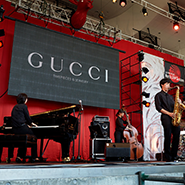- About
- Subscribe Now
- New York,
October 8, 2014

 Gucci's Grammy Camp performance
Gucci's Grammy Camp performance
Forty percent of donations from ultra-high-net-worth individuals in the United States goes toward educational causes, according to a report by Wealth-X and Arton Capital.
The report notes that UHNW individuals are focusing on philanthropic initiatives that present long-term solutions to deep-seated problems, such as programs that promote entrepreneurial pursuits. Philanthropists also prefer to have measurement systems in place that can track and assess the cumulative efficacy of donations.
"Philanthropy is a key aspect of the anatomy of many ultra affluent individuals who have decided they want to leverage their resources to give back or have an impact beyond making more money," said David Friedman, president of Wealth-X, New York.
"Their philanthropy has a direct connection to their heart and spirit and is one of the best platforms around which to cultivate a deeper relationship," he said. "Several of our largest luxury clients have used our data to map the philanthropic graph across their top and key clients so that they can partner in joining and supporting many of their top client’s selected causes and issues.
"It offers brands the ability to transcend the category of luxury and peer into the heart, mind and soul of their most valuable clients."
The "Wealth-X and Arton Capital Philanthropy Report 2014" tracks trends in UHNW charitable giving in the U.S.
Put to good use
With all the tools available for tracking consumer data, it makes sense that transparency in many other realms would eventually increase as well.
In fact, many philanthropists now expect to see breakdowns of how funds are used and if the ensuing efforts have made an impact. Some argue that this approach may be intrusive and even irrelevant, since it is often difficult to quantify the results of philanthropy in short periods of time.
However, this reliance on data can also raise the size of donations. If a philanthropist sees that a donation is having an outsized impact, she may commit a larger amount of funds to capitalize on likely success. On the other hand, poor performance can lead to less funds.
Getaway 2 Give promotional image
Through this process, organizations are held to a higher standard and arguably undertake more effective projects since they know they have to produce tangible results.
The survey found that the average ultra-wealthy philanthropist is 64, has an average net worth of $240 million and donates $25 million throughout his or her life.
UHNW individuals donate at least $60,000 per year, according to the report
Female philanthropists tend to give more than their male counterparts. Individual gifts from female donors are 26 percent higher on average than gifts from males.
Brands can leverage the results-driven giving patterns of UHNW individuals by either promoting the results of brand efforts or enlisting consumers to collaborate on initiatives.
Many brands already recognize this potential.
For instance, the CEO of Gucci at the FT Business of Luxury Summit 2013 said that the long-term goal of the Italian brand’s philanthropic efforts is to enhance its reputation and meaning to consumers.
Gucci's Grammy Camp initiative
The “Philanthropic Power” session commenced with a keynote from Gucci’s CEO and a panel moderated by Gillian de Bono, editor of FT’s How to Spend It, with other participants from Salvatore Ferragamo, Fabergé and the Austrian Museum of Applied Arts/Contemporary Art. Luxury brands, such as those represented during this session, are supporting charitable causes now to do what executives feel is right, but there are likely to be long-term benefits (see story).
More opportunities
There was an increase in the combined wealth of the world’s billionaires this year, a population that is largely represented by European countries, according to a report by Wealth-X and UBS.
The “Wealth-X and UBS Billionaire Census 2014” examines the locations of the world’s billionaires, as well as the age, gender and source of wealth. With an increased knowledge of the world’s wealthiest individuals, luxury brands will have a better understanding of top consumers (see story).
Predictably, UHNW individuals are scrupulous with their finances and brands must effectively tailor initiatives to court partners in this space.
"One of the most surprising highlights of the report was the contrast between life time giving for billionaires at around 3 percent vs. 6 percent for the average middle class American," Mr. Friedman said.
"While it appears at first glance that the average American is giving a greater percentage of their net worth than billionaires and from the numbers this is true, it is often more challenging for billionaires to give away large amounts as there is an incredible amount of due diligence and selection that has to be done for non-profits who can handle large donations," he said.
Final Take
Joe McCarthy, staff writer on Luxury Daily, New York
Share your thoughts. Click here